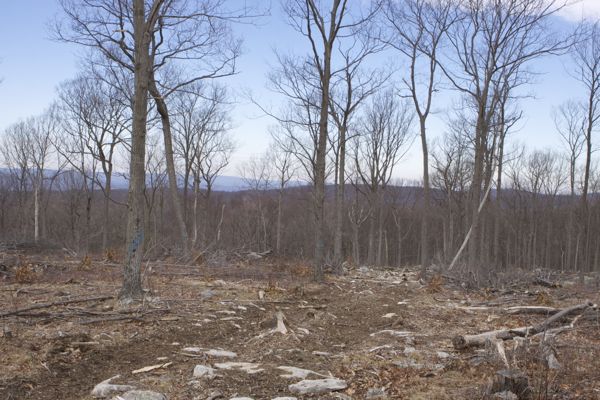Christie DEP Highlands Logging Plans Would Reduce The Forest’s Carbon Storage Capacity and Worsen Climate Change
Another Horrible Climate Policy by the Christie Corporate Crew
Logging Plans conflict with DEP’s own Climate Change Report Recommendations
Climate issue another in a long list of reasons to abandon Christie DEP logging plans
[Update below]
It is well known that the Christie Administration is irresponsibly outright hostile to any plans or programs to address climate change, and instead has actively promoted new fossil fueled gas plants and pipelines across the state, while suing to block the Obama EPA Clean Power Plan climate initiative.
But here’s an aspect of that climate negligence that has gotten no attention: reducing the ability of NJ’s forests to store carbon.
The controversial proposed DEP logging plan for Sparta Mountain is not NJ Audubon’s or DEP’s first logging operation.
Highlands forests are under assault from the State agency directed by the Highlands Act to preserve them.
Getting virtually no attention are the facts that NJ Audubon also logs Newark watershed lands (see page 43) and DEP has proposed logging not only at Sparta Mountain but in Weldon Brook WMA and Mahlon Dickerson Reservation.
Some think that Hamburg Mountain is next in line for logging.
The cumulative effects of these logging operations – on forest health, water resources, ecosystems, wildlife habitat, recreation, or climate change – have not been considered by the DEP. Not at all. No consideration.
There is no Statewide Plan that evaluates logging of NJ Forests, particularly with respect to the implications for climate change and carbon sequestration.
With respect to the climate change and forest carbon sequestration, the USGS recently released a study that suggests DEP’s logging plans – which remove the largest, oldest, and most valuable trees from the forest – is ill advised from a climate perspective, see: Large Old Trees Grow Fastest, Storing More Carbon
Trees do not slow in their growth rate as they get older and larger — instead, their growth keeps accelerating, according to a study published today in the journal Nature.
“This finding contradicts the usual assumption that tree growth eventually declines as trees get older and bigger,” says Nate Stephenson, the study’s lead author and a forest ecologist with the U.S. Geological Survey. “It also means that big, old trees are better at absorbing carbon from the atmosphere than has been commonly assumed.”
Another study of so called “forest thinning” raised similar concerns: THINNING FORESTS FOR BIOENERGY CAN WORSEN CLIMATE
A new study out of the Geos Institute in Ashland, Oregon concludes that selectively logging or “thinning” forests for bioenergy can increase the amount of carbon dioxide in the atmosphere and exacerbate climate change.
The study, “Thinning Combined With Biomass Energy Production May Increase, Rather Than Reduce, Greenhouse Gas Emissions,” by D.A. DellaSala and M. Koopman, challenges bioenergy and timber industry assertions that logging forests will aid in the fight against climate change.
The closest thing I could find to a NJ analysis of the management of carbon sequestration capacity of NJ’s forests was this US Forest Service Annual Survey.
This survey repeats the false assumptions discredited by the USGS study with respect to the carbon sequestration capacity of “young” versus “old” forests and suggests the unmet challenge for managing forests to store carbon:
Collectively, forest ecosystems represent the largest terrestrial carbon sink on earth. The accumulation of carbon in forests through sequestration helps to mitigate emissions of carbon dioxide to the atmosphere from sources such as forest fires and burning of fossil fuels. […]
Carbon stocks in New Jersey’s forests have increased substantially over the last several decades. The majority of forest carbon in the State is found in relatively young stands dominated by moderately long-lived species. This suggests that New Jersey’s forest carbon will continue to increase as stands mature and accumulate carbon in above- and belowground components. Given the age class structure and species composition of forests in New Jersey, there are many opportunities to increase forest carbon stocks. Managing for carbon in combination with other land management objectives will require careful planning and creative silviculture beyond simply managing to maximize growth and yield.
But the DEP’s Sparta Mountain and other “Forest Stewardship” plans completely ignore the carbon sequestration issue.
That’s not “Stewardship” or the “careful planning” USFS recommends, it’s logging.
The Christie DEP’s climate negligence is particularly egregious, given DEP’s own 2009 Report on implementing the Global Warming response Act (GWRA).
One of the specific recommendations of that Report were to “Adopt amendments to the New Jersey Forest Stewardship legislation” to address carbon sequestration as one strategy to achieve the GWRA goals for the year 2020. DEP also recommended that regulations “Require any State-funded projects to comply with the no net loss goal of forested area and tree replacement provisions of the “No Net Loss Act” (see Table ES1)
That DEP GWRA report has been abandoned and suppressed, so few know that it found that terrestrial carbon sequestration could “absorb” 5% of NJ’s CO2 emissions (almost 7 million tons):
This report lays out a recommended framework for attaining the 2050 GHG limit that focuses on taking aggressive action in key sectors where the greatest GHG emissions reductions can be gained over the long term. These areas are: land use planning and transportation; terrestrial carbon sequestration; energy efficiency and renewable energy; and new technologies and markets that support a climate-friendly economy. […]
While most of the GHG recommendations outlined in this Report focus on reducing the amount of CO2 and other GHG emissions emitted into the atmosphere, it is just as important to maintain, and increase, our natural sinks that absorb and sequester CO2. There is a growing body of research that indicates a significant potential for creating GHG mitigation through agriculture, forestry and vegetative measures. Forests play a critical role in climate change by sequestering or storing large quantities of carbon by absorbing CO2. Photosynthesis and respiration are the essential machinery by which forests store and release carbon. As a tree grows and increases in biomass, it absorbs CO2 from the air and, through the process of photosynthesis, uses solar energy to store carbon in its roots, stems, branches, and foliage. Some carbon is released back into the atmosphere as CO2 during respiration, but a living tree acts as a carbon “sink”; storing more carbon than it releases. Trees continue to accumulate carbon until they reach maturity, at which point about half of the average tree’s dry weight will be carbon. Nationwide, the U.S. Department of Agriculture projects that forest, crop, and grassland conservation efforts can play a unique role in reducing the GHG intensity of the U.S. economy. Increasing carbon sequestration in soils has become a viable way of augmenting the reduction of atmospheric GHG emissions. A 2007 study found that forest management practices would provide the lowest cost offset options in most regions of the United States.
The climate crisis demands that we systematically use every tool to reduce greenhouse gas emissions – and carbon sequestration in forests in a part of that strategy.
The climate issue is just another in a long list of reasons to abandon the Christie DEP logging initiative.
[Update – 5/6/16 – The larger context for this post:
American Forests Face Major Changes
In the north-east of the US, the great stands of maple, beech and birch, and the combinations of spruce or fir and pine, will prove vulnerable, they say, to the drought conditions predicted for the second half of the 21st century. ~~~ end update]


